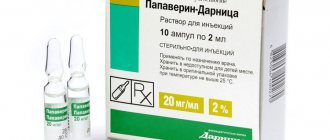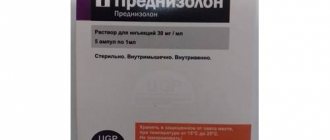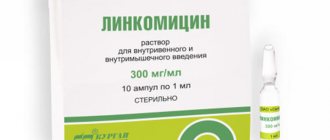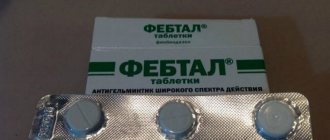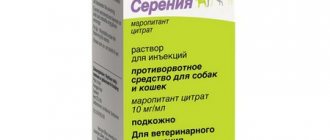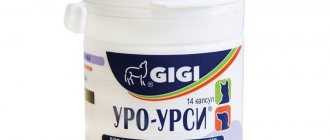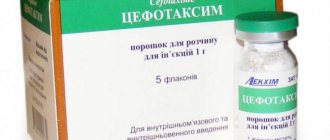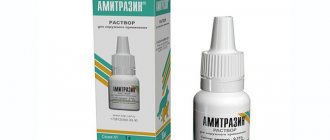Prednisolone for cats: indications and contraindications
The decision to use the corticosteroid hormone Prednisolone or its analog Prednisone is made by a veterinarian for the treatment of the following diseases and pathological conditions:
- diseases of the musculoskeletal system;
- anemia;
- allergic reactions, bronchial asthma;
- cancers of the circulatory system;
- nephritis, renal coma;
- adrenal gland diseases;
- conjunctivitis;
- blepharitis;
- eczema, dermatitis.
Prednisolone is contraindicated in the following situations:
- renal failure;
- diabetes;
- ulcerative lesions of the intestines and stomach;
- pregnancy and lactation;
- during the period of antibody production after vaccination;
- during the treatment of infectious diseases.
Restrictions
If it is necessary to use a solution for parenteral administration according to indications, individual intolerance to the substances is considered a significant contraindication to its use.
From the instructions for use of “Prednisolone” intravenously it is known that in other situations there are several pathological conditions of the body in which the medication is not used:
- Peptic ulcer disease (a chronic disease characterized by the presence of periods of remission (a period of time during which the disease does not manifest itself) and exacerbation; and is accompanied by the formation of ulcers (damage to the mucous membrane) in the stomach or duodenum).
- Gastritis with high acidity (inflammation of the mucous (inner) lining of the stomach wall).
- Diverticulitis (intestinal disease characterized by inflammation of blind-ending protrusions of its wall).
- Nonspecific ulcerative colitis (a type of chronic inflammatory disease of the large intestine of unknown etiology).
- Herpetic infection (a chronic infectious disease that is provoked by the herpes simplex virus and is characterized by damage to the integumentary tissues and nerve cells).
- Shingles (a disease caused by the herpes virus).
- Chicken pox (an infectious disease with airborne transmission, characterized by fever, as well as rashes on the skin and mucous membranes in the form of small blisters with transparent contents).
- Amebiasis (anthroponotic invasion with a fecal-oral transmission mechanism, which is characterized by chronic recurrent colitis with extraintestinal manifestations).
- Measles (an acute disease that manifests itself with a temperature of more than 39 degrees, as well as severe intoxication, cough and rash).
- Strongyloidiasis (parasitic, chronic, anthroponotic infection).
- Systemic mycosis (a number of severe diseases caused by a fungus).
- HIV (a slowly progressive disease caused by the human immunodeficiency virus).
For what diseases is it still prohibited to use the drug? From the instructions for use of “Prednisolone” intravenously it is known that the solution is contraindicated in the following conditions:
- AIDS (late manifestation of infection of the body with the human immunodeficiency virus).
- Time before vaccination.
- Previous myocardial infarction (one of the clinical forms of cardiac ischemia, occurring with the development of ischemic necrosis (local tissue death) of a section of the myocardium (the muscular middle layer of the heart, constituting the bulk of its mass), due to the absolute or relative insufficiency of its blood supply).
- Hypertension (an illness of a chronic nature, which is characterized by a persistent increase in blood pressure to high numbers due to a violation of the regulation of blood circulation in the human body).
- Hypertriglyceridemia (a disease in which the level of triglycerides in the blood increases).
- Diabetes mellitus (a disease of the thyroid system, which is characterized by an absolute or relative deficiency in the body of insulin, a pancreatic hormone, resulting in the development of hyperglycemia).
- Thyrotoxicosis (a process occurring in the human body due to a persistent increase in the number of thyroid hormones).
- Hypothyroidism (a syndrome that develops when the concentration of thyroid hormones is low, is one of the most common diseases).
- Itsenko-Cushing's disease (a disease in which there is an increased level of glucocorticoid hormones of the adrenal cortex in the blood).
- Pregnancy.
- Osteoporosis (a progressive skeletal disease with decreased bone density and increased risk of fractures).
- Myasthenia gravis (neuromuscular damage, which is caused by pathological fatigue of striated muscles).
- Poliomyelitis (an infectious disease characterized by damage to the gray matter of the spinal cord by poliovirus and pathology of the nervous system).
Before using the solution, the doctor must make sure there are no contraindications. How to administer Prednisolone intravenously?
Prednisolone for cats: dosage
The dosage of the medicine in injection or tablet form is prescribed by a veterinarian based on the following considerations:
- to stop the inflammatory process, use 0.3-0.5 mg/kg body weight once or twice a day;
- the maximum permissible daily dose for a cat is 5 mg;
- for the treatment of diseases of a tumor nature, the dosage is 1.0-1.5 mg/kg with a maximum daily dose of 7 mg/animal.
Drops are used to treat inflammatory eye diseases. As part of complex therapy for skin diseases, Prednisolone is used in the form of an ointment for external use.
Prednisolone for cats: instructions for use for different forms
The drug is used for cats in the following therapeutic forms:
- Injection. Available in ampoules of 1 or 2 ml. The content of the active substance in one vessel is 30 mg. The course of treatment should not exceed 7 days. The dosage is determined by the veterinarian depending on the condition of the pet’s body and the severity of the disease.
- Pills . Prescribed when there is no need to give injections. For cats, it is convenient to use 1 mg pills; they constitute a single dose for an animal weighing 3.0-3.5 kg. Unless otherwise prescribed by your veterinarian, the tablets are taken twice daily for two weeks.
- Ointment . Used as part of complex treatment of skin diseases characterized by severe inflammation. Before using the drug, the pathological surface is cleaned of crusts and exudate, and the hair is cut off. The ointment is applied in a thin layer, covering up to 1 cm of clinically healthy skin surface. Depending on the severity of the inflammatory process, the procedure is carried out 1 or 2 times a day. The duration of treatment is no more than 7 days.
- Drops . Used as part of complex therapy for diseases whose symptoms are inflammatory eye diseases. The standard treatment regimen involves applying 1 drop 3 times a day to each eye, even if only one hurts. The course of treatment is until recovery, but not more than 10 days. Before instillation, the pathological surface is freed from crusts and secretions.
Ointment
Possible side effects due to the use of Prednisolone ointment: steroid acne, purpura, telangiectasia, burning, itching, irritation and dry skin.
Long-term use and/or application of ointment to large surfaces may cause the development of hypercortisolism due to the resorptive effect of prednisolone. In such cases, you need to stop using the drug and consult a specialist. If the described side effects worsen, or if any other reactions not listed in these instructions occur, you should report them to your doctor.
Eye drops
After instillation of prednisolone, a transient burning sensation is possible. The result of prolonged use may be an increase in intraocular pressure, and therefore drugs containing GCS are used for no more than 10 days and under regular monitoring of intraocular pressure. Continuous use of the ophthalmic suspension for 3 months or more may cause the development of posterior capsular cataracts.
Composition of the drug
One tablet contains the active substance 1 or 5 mg, colloidal silicon dioxide, stearic acid, magnesium stearate, potato and corn starch, lactose monohydrate and talc.
Prednisolone ampoules contain 30 mg per 1 ml of active substance, sodium pyrosulphide, disodium edetate, sodium hydroxide, nicotinamide, water for injection.
Prednisolone ointment contains 0.05 g of active substance, glycerin, white soft paraffin, stearic acid, propyl and methyl parahydroxybenzoate and purified water.
Release form
Prednisolone is available in the form:
- Tablets in dosages of 1 and 5 mg,
- Solution for injection with a volume of 15 mg/ml 2 ml and 30 mg/ml 1 ml,
- Ointments with a dosage of 0.5%,
- Eye drops dosage is also 0.5%.
It belongs to a type of corticosteroid and sometimes, along with the name Prednisolone, you can also find Prednisone. The drug is freely available in pharmacies.
The main purpose of corticosteroids is to replace the natural hormone cortisol, which is produced by the adrenal cortex. There is an effect of corticosteroids on the immune system, as a result of which the production of substances that cause autoimmune and inflammatory reactions is blocked.
Indications for use of the drug
Prednisolone is best suited for use in emergency situations, when it is necessary to get your pet out of a serious condition as quickly as possible. Usually in such cases they resort to intramuscular injections to ensure immediate entry of the main active substance into the cat’s blood.
So, Prednisolone is indicated for cats for:
- Anemia;
- Bronchial asthma;
- Joint lesions - rheumatoid arthritis, rheumatism,
- Osteoarthritis;
- Renal coma;
- Leukemia;
- Acute adrenal insufficiency;
- Lipoid nephrosis;
- Weeping lichen;
- Dermatitis;
- Blepharitis;
- Inflammation of the ocular mucous membrane and its damage;
- Conjunctivitis.
This list can be continued, since there are other diseases that can be treated with this hormone, which has a strong effect.
In order to get a positive result from the treatment and not aggravate your pet’s condition, strict adherence to dosages will be required.
Purpose
The main use of Prednisolone is the elimination of anaphylactic reactions, the treatment of allergic symptoms that do not respond to standard therapy. The drug is best suited for use in emergency cases, when it is extremely necessary to quickly remove the cat from a serious condition. Indications for prescribing the medicine are:
- atopic dermatitis;
- eczema;
- osteochondrosis;
- rheumatoid arthritis;
- endocrine disorders;
- blepharitis;
- conjunctivitis;
- angioedema, etc.
Important!
Prednisolone can be used for an allergic reaction of unknown etiology.
The spectrum of therapeutic action of the drug includes diseases of the hematopoietic system, including anemia, leukemia, leukemia, pathologies of the respiratory system, liver, and kidneys. For serious brain injuries that cause brain swelling, Prednisolone can save your pet's life. In this case, Prednisolone injections are used for emergency assistance.
Atopic dermatitis is one of the manifestations of allergies in domestic cats. It is less common than flea dermatitis, food reactions, and is a hypersensitivity reaction to allergens in the environment. Presumably, this reaction is associated with a genetic or hereditary predisposition of animals.
The pathology has no characteristic clinical manifestations
A caring owner will notice that the cat begins to itch and lick itself frequently. Itching is the primary symptom of the disease, and it can be localized in the muzzle, ears and neck, and front paws
Excessive licking and scratching can lead to self-injury and the appearance of bald areas on the body. The fur breaks off and the animal's appearance deteriorates.
Important!
Atopic dermatitis entails a number of unpleasant consequences, including:
- miliary dermatitis (cat scab) - manifested by multiple small nodules with redness underneath, located on individual parts of the body or most of the skin;
- otitis externa – inflammation of the hearing organ;
- food hypersensitivity reactions;
- dermatophytosis (ringworm);
- demodicosis and others.
Manifestations of atopic dermatitis can be caused by various allergens: pollen and tree flowers, plants, mold, insects, epidermis, bird feathers, tobacco, house and street dust, etc. To accurately determine the allergen, testing is necessary. Prednisolone will help relieve allergy symptoms.
Contraindications for use
Prednisolone contains components that can cause a negative allergic reaction in your pet. That is why there are a number of contraindications to the use of this drug, which you should definitely be aware of. Prednisolone is strictly contraindicated for:
- Kidney failure
- Gastric ulcer,
- Diabetes mellitus
- Tuberculosis,
- Infection with a viral infection,
- Vaccinations,
- Cat pregnancy and lactation period,
- Individual hypersensitivity to the main active ingredient.
Side effects
What kind of troubles can you expect from taking Prednisolone? You need to be wary if signs such as:
- Decreased appetite
- The occurrence of allergic reactions,
- A sharp increase in weight or, conversely, a sharp decrease in weight,
- The appearance of ulcers in the pet’s mouth, or inflammation of the gums,
- Deterioration of mental state in the form of apathy or aggression,
- Increased thirst
- Diarrhea or, conversely, constipation,
- Increased oiliness of the coat and its active loss.
If one or more of the above signs are noticed, it is recommended to immediately stop taking the drug and consult a veterinarian about further treatment.
Instructions for use of Prednisolone
The dosage of the drug in any form is prescribed based on the diagnosis and weight of the pet.
To treat inflammatory processes in a cat’s body, Prednisolone is prescribed for internal use in the following form: per 1 kg of pet’s weight from 0.3 to 0.5 mg of medication, the dosage per day should not exceed 5 mg. If the disease is acute, then the dose of the drug per day is increased to two times.
For immunosuppression, 1 or 1.5 mg of the drug per kilogram of animal weight is prescribed. The daily dosage should not exceed 7 mg. The frequency of administration is twice a day.
The duration of treatment with Prednisolone should not exceed two weeks.
The drug in the form of an ointment is applied in a thin layer to a previously shaved area of skin once or twice a day for five days or a maximum of a week.
The drug in the form of drops must be instilled one drop into each eye of the pet. The daily frequency is 2 or 3 times throughout the week or a maximum of 10 days.
Precautionary measures
Mistakes when administering Prednisolone to cats can seriously affect their health.
Therefore, when working with the drug, it is important to remember the following rules:
- Before using Prednisolone, you should wash your hands thoroughly with soap;
- During the manipulations, it is prohibited to consume drinks or food, or be distracted by smoking.
- If the owner of an animal has increased sensitivity to a hormonal drug, it is necessary to avoid contact of the drug with the skin or mucous membranes (mouth, eyes).
If this happens, you should rinse the contact area with plenty of water. In a situation where the drug accidentally entered the human body, you should immediately seek medical help.
shutterstock
It is important to determine a convenient place where manipulations with the animal will be most convenient. Treatment should not be administered in the kitchen, whether by injection or oral administration of the drug.
It is advisable to choose a flat, horizontal surface, especially for administering injections. It is advisable to administer prednisolone in this form slowly, without sudden movements. An assistant may be needed to hold and calm the cat while a second person administers the injection.
Do not use Prednisolone if the expiration date has expired (3 years from the date of manufacture). The drug should be stored at a temperature of 15-20 C in a place where it will not be found by children or pets.
Reviews about the application
You can leave your reviews about the drug Prednisolone for cats, other users will be interested in:
Tatiana
My cat is 7 years old. She lives permanently in an apartment and never goes outside. During the warm season, we almost always keep the window open. And one day a bee flew into the apartment. It was just Sunday and we were all at home. And my cat loves to hunt, and apparently decided to hunt a bee and grabbed it with her teeth. And then my pet screamed, and then she began to spin like a top, and a moment later she began to choke. I called the veterinarian who we always have for checkups. He said to urgently give an injection of prednisolone so that the cat would not die from anaphylactic shock. Fortunately, we have a pharmacy right in our house. The son rushed headlong there and brought medicine. They gave her an injection and after a while she felt better. I am very grateful to our doctor for his good recommendation, he helped save my pet.
Valeria
My cat is 3 years old and was diagnosed with asthma a month ago. We had complaints of a daily cough in the morning. An examination was carried out, we gave blood for analysis, and took x-rays. The X-ray showed everything was fine, but a slight inflammation was found in the blood. The cat was wormed and injected with Dexafort. After 12 days, the cough disappeared, and this only confirmed the correctness of the diagnosis. The veterinarian prescribed Prednisolone initially at a 5 mg dosage (1 tablet), and reduce the dosage until the cough reappears. At 1/8 it appeared, and we returned to the dosage of ¼. Now we take it this way, but I’m scared because this drug affects the adrenal glands. But I don’t know what to do.
Prednisolone was originally intended for the treatment of humans, but recently this drug has increasingly begun to be used in veterinary practice. The medication has a fairly powerful effect on the body, so it should be used strictly as prescribed by a doctor. Before starting use, it is important to read the instructions.
How to use the medicine correctly
The tablets should be given to the animal once a day before or during meals. The dose is calculated based on weight: 0.3 mg should be per 1 kg of body weight. The tablet can be given whole or pre-crushed and mixed with water. Then draw the resulting liquid into a disposable syringe without a needle and give it to the pet, fixing it and opening its jaws. The tablet can also be mixed with a small amount of wet food. The course of treatment often does not exceed 7 days.
The tablet can be given to the cat whole or after preliminary crushing
The solution is administered to the pet intramuscularly. For 1 kg of body weight, 0.3 ml of medication is needed. The drug is best injected into the thigh muscle. To do this, you need to fix the cat's limb and massage it. The muscle usually rolls under the fingers, so feeling it is not difficult. The needle must be inserted at a right angle of 1 cm. The solution must be released from the syringe very slowly, otherwise the animal may feel pain. Injections should be done once a day for no more than 5 days.
Intramuscular injection should be administered slowly and carefully
The ointment is applied to the affected areas of the skin 1-2 times a day
It is important to use a protective collar to prevent the cat from licking the medicine. The course of treatment with ointment should not exceed one week
The exact duration of therapy and the amount of medication must be agreed with the doctor.
The protective collar will help prevent the ointment from being licked off.
I used Prednisolone ointment to treat a cat who had a severe allergic reaction. Unfortunately, the reason was never found out. The veterinarian prescribed the drug after examining and collecting tests. The pet was bothered by constant itching and rashes, which caused her hair to fall out. The cat licked and combed the affected areas, as a result of which sores appeared. At first she used Suprastin for treatment, but it did not work. Then I switched to Prednisolone. The ointment was applied only to the affected areas. Moreover, in a short time all the sores healed, and the animal stopped actively licking itself. I didn’t notice any side effects from the therapy right away, but at the end of the course of treatment it became clear that the cat had gained a lot of weight. Unfortunately, the symptoms returned after stopping the ointment.
Precautionary measures
What to consider when working with the drug:
Without a doctor's prescription, it is not recommended to mix Prednisolone and other medications in one syringe. During treatment with the drug, postpone vaccination of your pet. During long-term therapy, it is important to monitor the animal's blood pressure levels, this is especially important for older cats. In the presence of bacterial infections, the drug is recommended to be used in conjunction with antibiotics. The medication should be used with caution to treat kittens, especially when it comes to long-term therapy. If you do not have the skills to inject medication, it is best to give injections in a hospital setting or entrust the procedure to a medical professional. If the animal’s condition worsens during therapy, it is important to cancel the course and inform the doctor. It is recommended to wear disposable gloves before administering the injection and when working with tablets. For injections, it is best to use an insulin syringe with a short needle. Do not combine the drug with anticoagulants.
For injections, it is best to use an insulin syringe
What is Prednisolone
Prednisolone is a synthetic glucocorticosteroid drug that helps eliminate the inflammatory process. Available in five varieties. The active ingredient for all dosage forms is prednisolone. The medicine has the following properties:
- reduces the intensity of pain;
- relieves swelling;
- eliminates acute allergic reactions;
- reduces symptoms of itching;
- reduces the number of rashes due to dermatitis;
- accelerates tissue healing;
- constricts blood vessels.
This medicine helps to cope with the shock that occurs with severe burns, injuries and anaphylactic reactions. In the treatment of cats, the drug is also used as an auxiliary method for the treatment of adrenal diseases. Sometimes Prednisolone even helps to save a pet’s life, for example, with progressive swelling of the larynx.
Prednisolone is a glucocorticosteroid medication
Attention! Glucocorticosteroid medications have a systemic effect on the body. Under no circumstances should you give them to your pet uncontrollably.
Characteristics of tablet form
The tablets are intended for oral administration. In addition to the active component, the composition includes:
- colloidal silicon dioxide;
- potato starch;
- stearic acid;
- magnesium stearate;
- talc;
- povidone;
- corn starch;
- lactose monohydrate.
The drug can be stored in tablet form for three years at a temperature not exceeding 25 degrees. If necessary, the medication can be kept in the refrigerator, but freezing should be avoided.
Prednisolone tablets are intended for oral administration
Attention! The tablets can be harmful if taken accidentally, so it is important to keep them away from children and animals.
Injection
The solution is intended for intravenous and intramuscular injections. Auxiliary components for this release form:
- nicotinamide;
- sodium metabisulfite;
- disodium edetate;
- sodium hydroxide;
- water d/i.
Prednisolone solution is intended for injection.
It is recommended to store the solution in a cool place or at room temperature not exceeding 25 degrees. The medication is valid for three years; after this period, this form cannot be used for treatment.
Composition and storage conditions of the ointment
Prednisolone in the form of ointment is one of the safest forms of release. In addition to the active substance, the medication contains:
- glycerol;
- petrolatum;
- stearic acid;
- emulsifier;
- methyl parahydroxybenzoate;
- propyl parahydroxybenzoate;
- purified water.
The shelf life of the ointment is the same as that of the solution. It is important to pay attention to the integrity of the packaging. If the protective membrane is opened, the drug cannot be used.
Prednisolone ointment is used externally only
The normal color of the ointment is white. If the shade turns yellow or some impurities appear in the composition, then it is possible that the storage conditions have been violated. This ointment cannot be used for treatment.
Eye drops and lyophilisate
Drops are used for ophthalmological diseases. In addition to prednisolone, the composition includes special-purpose water. The drops should be stored for no more than three years at a temperature not exceeding 25 degrees. These conditions do not apply to the opened bottle, which can be kept in the refrigerator and used for 4 weeks.
The lyophilisate contains prednisolone hemisuccinate in powder form intended for dilution and injection use. The drug in this form is stored under the same conditions as the solution.
Lyophilisate is rarely used to treat pets, since it requires preliminary dilution with water, which is not always convenient. Instead of this form, a regular injection solution is most often preferred.
Prednisolone tablets for coronavirus
Chemical compound of the same name as an active component. The dosage depends on the manufacturer. Typical excipients: starch, sucrose, stearic acid. There may be other components, so you should first read the instructions for the specific drug. Prednisolone tablets can be used with the permission of a specialist and taking into account high-quality constant monitoring of the body’s condition. After hospitalization, doctors usually prescribe an injectable form of the drug.
Prescribed by a doctor
Medicinal properties
- Prednisolone acts as a synthetic glucocorticosteroid for coronavirus. Eliminates inflammation, allergic reactions, reduces the activity of the immune system and has additional features. It acts on special receptor structures in the cytoplasm and forms a special complex that determines the formation of proteins. This mode of action determines the medicinal effects of the drug.
- Has an effect on protein metabolism. During coronavirus infection, Prednisolone reduces the amount of globulins in the blood and reduces the production of albumin in the liver and kidney tissue. Reduces the formation and enhances the breakdown of proteins in muscles.
- Affects fat metabolism. Increases the formation of higher fatty acids and triglyceride complexes. Affects lipid distribution in the body. Causes an increase in cholesterol levels.
- Metabolism of sugars: increases the absorption of carbohydrate components from the digestive system. Increases the effect of G6P by increasing the flow of sugar from the liver tissue into the bloodstream. Enhances the action of enzymes and the formation of aminotransferases. Activates glucose synthesis in the liver. Increases blood sugar levels.
- Water-mineral balance: reduces sodium output in urine, increases potassium output, reduces the absorption of calcium components in the digestive tissue. Reduces bone mineral density.
Against inflammation and complications of infection
The anti-inflammatory effect of the drug is due to blocking the release of eosinophils and mast cells. The release of inflammatory factors from these cells is reduced. Promotes the formation of lipocortins and reduces the number of mast cells that synthesize hyaluronic acid. A decrease in capillary permeability is associated with a decrease in inflammation during the use of Prednisolone for coronavirus infection. Stabilizes cell membrane structures. Affects all stages of inflammation, including inhibition of the release of prostaglandins and other factors. Suppresses the formation of inflammatory cytokines, including interleukin 1 and TNF-alpha.
Increases the resistance of the membrane structure of cells to negative external influences. Suppression of the immune system is associated with the resulting involution of lymphatic structures and suppression of lymphocyte division. The proliferation of B-lymphocytes and the effects of different types of these cells are blocked. The production of immunoglobulins decreases. The effect of Prednisolone in relation to allergies is associated with a decrease in the formation and production of allergic factors. The work of mast cells and basophils is stabilized, so there is no selection of histamine and other chemical compounds that cause symptoms.
Effect on the respiratory system
For obstructive pathologies of the respiratory organs, tablets or other dosage forms of Prednisolone eliminate the inflammation that causes such symptoms. This is the prevention or correction of epithelial swelling. The distribution of eosinophils in the tissues of the bronchial tree is reduced. The accumulation of these cells in organs is prevented. The number of protective complexes is reduced and damage to the mucous membrane is inhibited.
The tablets increase the susceptibility of beta adrenergic receptors of bronchial tissues to internal catecholamines and other chemical compounds that facilitate breathing. The viscosity of sputum is reduced by reducing its formation. Blocks the formation and production of adreno-corticotropic hormone. Reduces the production of internal corticosteroids. Suppresses inflammation in the connective tissue area and reduces the likelihood of scarring.
When is medication prescribed - table
| Release form | Indications |
| Pills |
|
| Solution |
|
| Ointment |
|
| Eye drops |
|
| Lyophilisate |
|
Drugs with similar effects on the body - table
| Name | Release form | Active ingredient | Indications | Contraindications | Negative reactions | Possibility of use during pregnancy | Price |
| Hydrocortisone |
| hydrocortisone acetate | To eliminate acute hypersensitivity reactions, traumatic shock, allergic diseases and inflammatory processes. |
|
| No | From 150 rub. |
| Dexamethasone |
| dexamethasone phosphate | To get rid of cerebral edema, inflammatory and allergic diseases, as well as to treat endocrine disorders. |
|
| No | From 100 rub. |
| Dexafort | Suspension |
| To eliminate symptoms of bronchial asthma, anaphylactic reactions, burns and dermatological diseases. |
|
| No | From 950 rub. |
Similar medicines - photo gallery
Dexafort is intended specifically for the treatment of animals. Hydrocortisone can provoke digestive disorders. Dexamethasone is not recommended for use in acute gastrointestinal diseases in a pet.
Operating principle
Prednisolone is able to suppress the activity of leukocytes, thereby reducing the intensity of the body's inflammatory response. This reduces the permeability of the vascular walls and the synthesis of prostaglandins - mediators that are responsible for the occurrence of pain. In addition, this glucocorticosteroid affects the production of histamine, the main provocateur of an allergic reaction.
Prednisolone is often used for allergies in cats of unknown cause.
The active component also increases blood glucose levels and is quickly absorbed by any method of application. In addition, this drug replenishes the deficiency of adrenal hormones. However, the drug not only has a positive effect, but can also provoke excessive production of hydrochloric acid, which contributes to the appearance of stomach ulcers.
Attention! Prednisolone can disrupt your pet's metabolism when used over a long period of time, promoting fat accumulation. In this case, the cat recovers quickly, but its appetite may remain unchanged.
Features of application
The treatment regimen depends on the specific pathology, since the drug can be used for long-term therapy, as well as as an emergency treatment. The veterinarian determines which release form to use after a series of studies and diagnosis.
Tablets: treatment regimen and dose
The dose is calculated based on the pet's weight. For 1 kg, 0.3–0.5 mg of the drug is provided. Tablets can be given mixed with food or forcibly 2 times a day for 14 days. The exact course is determined by the doctor depending on the nature of the pathology. In order for the pet not to notice the presence of the medicine in the food, the tablets must be thoroughly crushed. If this method is not suitable, then the drug can be placed on the root of the cat’s tongue or infused using a disposable syringe after preliminary crushing and mixing with water.
Disease prevention
There are no special preventive measures to protect against the disease. Prevention consists of careful monitoring of animals that are at risk for cardiovascular and colds. These are predisposed breeds (Maine Coons, Sphynxes, Persians, Scottish, British), weakened, with low immunity, overweight, animals that move little.
If the disease is cured in time, then we can say with a high degree of confidence that complications will not develop.
The main preventive measures are:
- protect the cat from physical overload;
- protect from unfavorable environmental conditions (avoid overheating and hypothermia, being in drafts);
- monitor the safety of cats and kittens at home (protect access to wires and electrical appliances, ensure that the animal cannot inhale fumes of aggressive chemicals, protect from falls and injuries);
- strengthen the immune system, do not skip scheduled vaccinations;
- undergo regular preventive examinations with a veterinarian.
The disease often has a poor prognosis
But the attention and love of the owner can work a miracle. Competent and timely veterinary care (especially in non-cardiogenic disease) makes the chances of recovery quite high
source
Can it be used to treat pregnant cats and kittens?
Glucocorticosteroid drugs cannot be used to treat pregnant and lactating cats, as such medications can cause dangerous consequences, including fetal death. Also, Prednisolone is not used to treat kittens. The drug can be used only from the first year of life.
The drug is not used to treat kittens.
Attention! Glucocorticosteroids penetrate the placental barrier and are also absorbed into breast milk, contributing to metabolic disorders in kittens.
